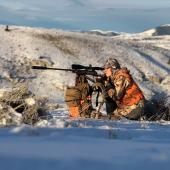Fido in the Field
Comparing hunting breeds.
Hunting and dogs: there’s no better combination. Not just the dogs themselves, with their athleticism and incredible sense of smell, but the experience of trekking through tall grass alongside your trusty companion, awaiting that explosion of wingbeats as a bird goes airborne in front of you.
The three main types of hunting dog—pointers, spaniels, and retrievers—are divided into two categories: pointing breeds and flushing breeds. As Chris Smith of BackCountry Bird Dogs explains, “Pointers are for pointing, and retrievers and spaniels are for flushing, and both groups can be taught to retrieve.”
When your pointer sidekick sniffs or hears game, its body will go rigid and point toward the scent or sound. Once your dog points you in the right direction, it’s typically up to you to flush out the animal and take the shot, though some pointers can be taught to flush on command. Pointers work at a distance from their hunters, and it can be difficult to keep an eye on them in thick cover—motion-sensor collars help, alerting the hunter when the dog is on point. Some pointers don’t retrieve, so be prepared to get some exercise and find your own game.
Like pointers, retrievers are named for what they do. These friendly pooches—Labs, goldens, etc.—are not only one of the most popular household dogs in the U.S., they’re also the most popular sporting dog. Retrievers typically have soft mouths, lots of energy, and high levels of endurance—perfect for long days of beating the brush and bringing back game.
Retrievers are also great for waterfowl hunting: they’re built for swimming, with insulated fur and webbed feet. The retriever is versatile and can be trained to stay close and flush birds only within range, making it a multi-faceted hunter.
Spaniels are the smallest of the three main sporting dogs. They have medium-to-long coats—ideal for colder-weather hunting, but slightly higher maintenance. “When you’re out on a hunt, all kinds of things get caught in pointers’ coats,” Smith says. “You have to make sure you get everything out. Some people don’t like that extra work.”
Spaniels can flush and retrieve, and are excellent with all types of game. They can also be taught to point. These dogs work close to their humans, stealthily sneaking up on the prey to flush it out.
There is no such thing as a best hunting dog—it’s relative to where and what you hunt. “If you hunt South Dakota, where there are a million pheasants, flushing dogs will work better,” Smith says. “You don’t want to take a pointer out there; it will just be spinning in circles, pointing and pointing at all the birds. If you’re hunting Montana, where the birds are sparser, pointers are better.”
“My favorite hunting dogs are dogs that hunt,” Smith quips. “I’ve seen mixed breeds… weird, weird mixed breeds, who are excellent hunting dogs.”
Hunting dogs don’t come packaged, so be prepared to invest some time into your partner. “A lot goes into training dogs, but no specific breed is easier to train than the next,” Smith says. “Dogs are just like people—each has its own personality, and some may take more work depending on the case.” As with anything involving firearms, follow all the usual protocols and stay safe out there.













